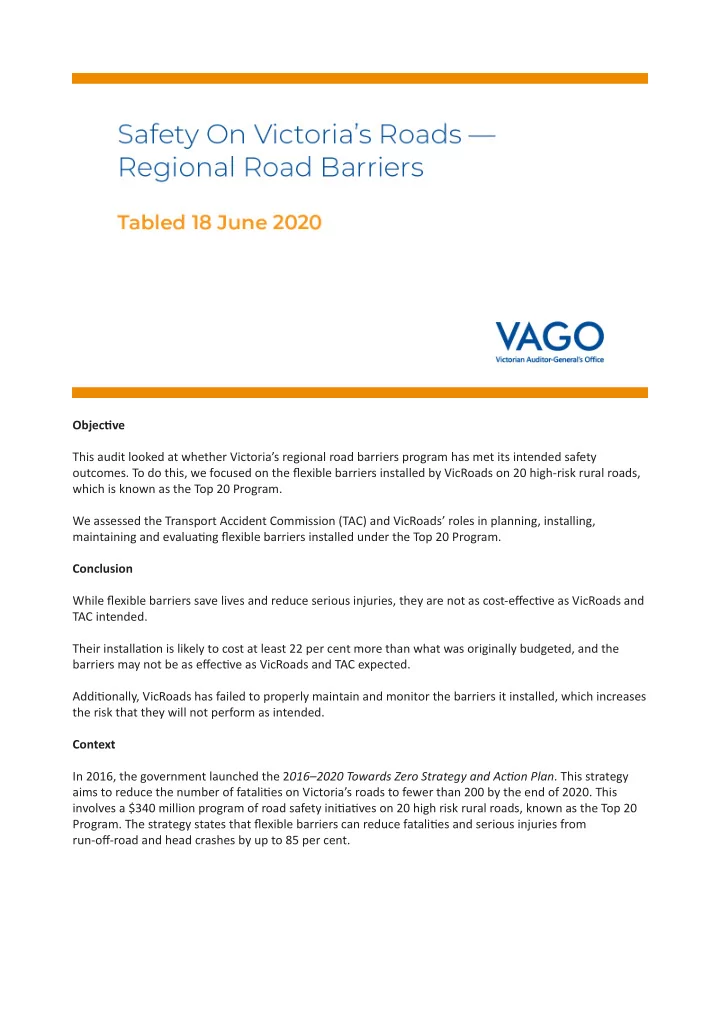

Objectjve This audit looked at whether Victoria’s regional road barriers program has met its intended safety outcomes. To do this, we focused on the fmexible barriers installed by VicRoads on 20 high-risk rural roads, which is known as the Top 20 Program. We assessed the Transport Accident Commission (TAC) and VicRoads’ roles in planning, installing, maintaining and evaluatjng fmexible barriers installed under the Top 20 Program. Conclusion While fmexible barriers save lives and reduce serious injuries, they are not as cost-efgectjve as VicRoads and TAC intended. Their installatjon is likely to cost at least 22 per cent more than what was originally budgeted, and the barriers may not be as efgectjve as VicRoads and TAC expected. Additjonally, VicRoads has failed to properly maintain and monitor the barriers it installed, which increases the risk that they will not perform as intended. Context In 2016, the government launched the 2 016–2020 Towards Zero Strategy and Actjon Plan . This strategy aims to reduce the number of fatalitjes on Victoria’s roads to fewer than 200 by the end of 2020. This involves a $340 million program of road safety initjatjves on 20 high risk rural roads, known as the Top 20 Program. The strategy states that fmexible barriers can reduce fatalitjes and serious injuries from run-ofg-road and head crashes by up to 85 per cent.
Planning We found that VicRoads did not suffjciently plan its fmexible barrier installatjon projects for the Top 20 Program. VicRoads and TAC also did not prepare a business case to support why the investment in fmexible barriers was the most cost-efgectjve solutjon. This meant there was no consolidated picture of the program’s costs, tjmelines and risks before it was approved. While not required by the Department of Treasury and Finance, it is betuer practjce to prepare a business case for signifjcant infrastructure projects. VicRoads selected 20 rural roads as the most dangerous but did not document how it chose them. It also did not state why it selected high volume roads when low volume roads have higher numbers of serious casualty crashes. VicRoads uses crash reductjon factors to indicate the expected efgectjveness of road safety infrastructure projects. Crash reductjon factors show how much, in percentage terms, the new infrastructure is likely to reduce the number of fatalitjes and serious injuries by. VicRoads was not able to tell us how it calculated the crash reductjon factors for its Top 20 Program projects, which are most likely overstated. Through our own analysis, we found that for the projects completed so far, the safety infrastructure installed has most likely decreased fatalitjes and serious injuries caused by run-ofg-road and head-on crashes by 46.5 per cent. This is below the result that VicRoads expected. Implementatjon Of the 21 completed projects, VicRoads has delivered 12 over budget and nine late. VicRoads is likely to spend at least $99.9 million, or 22 per cent, more on the Top 20 Program than it originally budgeted. VicRoads has a comprehensive suite of quality assurance mechanisms and sign-ofgs to ensure that new road safety infrastructure is installed to the right standards. However, VicRoads has limited oversight of how maintenance contractors inspect fmexible barriers and does not know which barriers require maintenance at specifjc points in tjme.
Evaluatjon VicRoads did not establish an evaluatjon framework when it was planning the Top 20 Program. It has now made plans to begin an evaluatjon, but does not expect to complete it untjl 2026. Data quality issues will hinder VicRoads’ ability to evaluate the program because it does not separately record where it has installed difgerent types of barriers. It also could not provide us with accurate project constructjon start and end dates. Recommendatjons We made 10 recommendatjons. Eight to VicRoads to improve its planning for major infrastructure projects and ongoing fmexible barrier maintenance, and two to TAC to strengthen its accountability over the road safety projects it funds. For further informatjon, please view the full report on our website www.audit.vic.gov.au
Recommend
More recommend